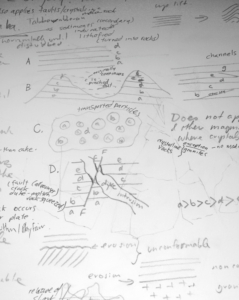Science Report for October 7th
Cross-training in Stratigraphy.
After a discussion about the word ‘orogeny ‘, this morning Anushree and I began an impromptu session of cross-training on the basic laws of stratigraphy (the writings of the strata) with geologist Jon Clarke.
Stratigraphy helps us realise and identify the order of the processes that form each layer of rocks in relation to a relative time-line. We were introduced to Steno’s Laws as a way of thinking about geology as a factual narrative science which builds a story from the relationships of rocks. Jon says context is everything!
When we think about our desert environment here at MDRS, we learnt that :
1. Sediments are laid down as horizontal strata until disturbed.
2. Young strata are laid down on older strata.
3. Strata laterally continue until interrupted.
4. Rock fragments are older than the sediments that contain them (like raisins in a cake are older than the cake itself).
5. Cross cutting features are younger than the features they cross with (whether its a fault or a crack or a dyke – all are younger).
6. Contact between rocks can be: conformable (horizontal layers); disconformable (with some part eroded away and re-layered horizontally and this may take millions of years); or unconformable (where the rocks are tilted on end then the next layers are laid down flat on top). Non-conformable is where sediments are laid down on top of eroded crystalline bedrock eg. granites, gneisses etc
These basic laws defined by Steno, Hutton, and others led to others deriving the succession of fossils (biostratigraphy). Archaeologists and forensic scientists use similar principles.
Most interesting for me was the easy way our crew geologist used drawing to help us understand relationships. Unless we were in the field and could observe from firsthand without diagrams, we would never have been able to think through these ideas.




